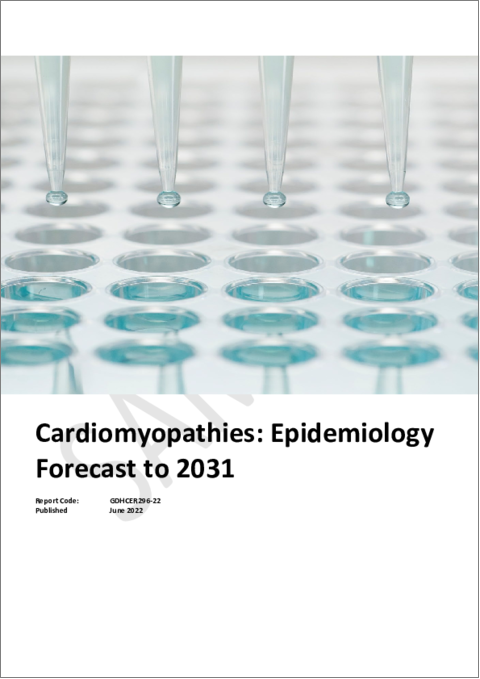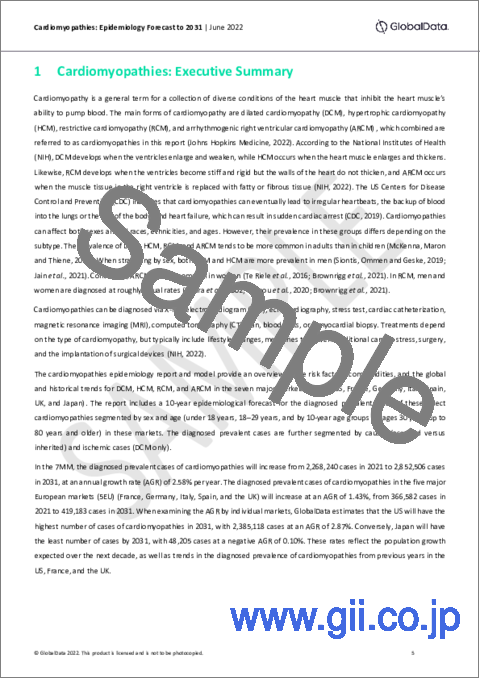|
|
市場調査レポート
商品コード
1100966
心筋症の疫学予測:2021~2031年Cardiomyopathies Epidemiology Forecast, 2021-2031 |
||||||
|
● お客様のご希望に応じて、既存データの加工や未掲載情報(例:国別セグメント)の追加などの対応が可能です。 詳細はお問い合わせください。 |
|||||||
| 心筋症の疫学予測:2021~2031年 |
|
出版日: 2022年06月13日
発行: GlobalData
ページ情報: 英文 38 Pages
納期: 即納可能
|
- 全表示
- 概要
- 図表
- 目次
7MMでは、心筋症の有病率診断例は、2021年の226万8,240人から、2031年には285万2,506人に、2.58%のAGRで増加すると予測されています。欧州5大市場(5EU)(フランス、ドイツ、イタリア、スペイン、英国)における心筋症の有病率診断例は、2021年の36万6,582例から、2031年には41万9,183例となり、1.43%のAGRで増加すると予測されています。
当レポートでは、世界の心筋症の疫学について調査分析し、疾患の背景、世界・過去の動向、心筋症の疫学予測、COVID-19の影響等に関する情報を提供しています。
目次
目次
第1章 心筋症:エグゼクティブサマリー
- 関連レポート
- 今後のレポート
第2章 疫学
- 疾患の背景
- リスク要因と併存疾患
- 世界および過去の動向
- 予測調査手法
- 情報源
- 予測の前提条件と方法
- 拡張型心筋症の有病率診断例
- 肥大型心筋症の有病率診断例
- 収縮性心筋症の有病率診断例
- 不整脈原性心筋症の有病率診断例
- 心筋症の有病率診断例(病因別)
- 虚血を伴う拡張型心筋症の有病率診断例
- 心筋症の疫学予測(2021~2031年)
- 心筋症の有病率診断例
- 心筋症の有病率診断例:サブタイプ別
- 心筋症の有病率診断例:年齢別
- 心筋症の有病率診断例:性別
- 心筋症の有病率診断例:病因別
- 虚血を伴う拡張型心筋症の有病率診断例
- 討論
- 疫学予測の洞察
- COVID-19の影響
- 分析の制約
- 分析の強み
第3章 付録
- 参考文献
- 1次調査-処方せん発行者調査
- 著者について
- 疫学者
- レビュアー
- 世界の治療分析および疫学のディレクター
- ヘルスケア事業および戦略のグローバルヘッド・EVP
- コンタクト情報
List of Tables
List of Tables
- Table 1: Risk factors and comorbidities for cardiomyopathies
- Table 2: High-prescribing physicians (non-KOLs), surveyed by country, 2022
List of Figures
List of Figures
- Figure 1: 7MM, diagnosed prevalent cases of cardiomyopathies, both sexes, all ages, N, 2021 and 2031
- Figure 2: 7MM, diagnosed prevalence of cardiomyopathies (%), men and women, all ages, 2021
- Figure 3: Sources used and not used for diagnosed prevalent cases of dilated cardiomyopathy
- Figure 4: Sources used and not used for diagnosed prevalent cases of hypertrophic cardiomyopathy
- Figure 5: Sources used for diagnosed prevalent cases of restrictive cardiomyopathy
- Figure 6: Sources used for diagnosed prevalent cases of arrhythmogenic cardiomyopathy
- Figure 7: Sources used for diagnosed prevalent cases of dilated cardiomyopathy by etiology
- Figure 8: Sources used for diagnosed prevalent cases of hypertrophic cardiomyopathy by etiology
- Figure 9: Sources used for diagnosed prevalent cases of restrictive cardiomyopathy by etiology
- Figure 10: Sources used for diagnosed prevalent cases of arrhythmogenic cardiomyopathy by etiology
- Figure 11: 7MM, diagnosed prevalent cases of cardiomyopathies in 2021, men and women, N, all ages
- Figure 12: 7MM, diagnosed prevalent cases of cardiomyopathies by subtype, men and women, all ages, N, 2021
- Figure 13: 7MM, age-specific diagnosed prevalent cases of cardiomyopathies, men and women, all ages, N, 2021
- Figure 14: 7MM, diagnosed prevalent cases of cardiomyopathies by sex, all ages, N, 2021
- Figure 15: 7MM, Diagnosed Prevalent Cases of Cardiomyopathies by Etiology, Men and Women, All Ages, N, 2021
- Figure 16: 7MM, diagnosed prevalent cases of ischemic dilated cardiomyopathy, men and women, all ages, N, 2021
Cardiomyopathy is a general term for a collection of diverse conditions of the heart muscle that inhibit the heart muscle's ability to pump blood. The main forms of cardiomyopathy are dilated cardiomyopathy (DCM), hypertrophic cardiomyopathy (HCM), restrictive cardiomyopathy (RCM), and arrhythmogenic right ventricular cardiomyopathy (ARCM). Cardiomyopathies can eventually lead to irregular heartbeats, the backup of blood into the lungs or rest of the body, and heart failure, which can result in sudden cardiac arrest (CDC, 2019).
GlobalData epidemiologists relied on the most robust country-specific data for each segmentation covered in this forecast, obtained from scientific studies published in peer-reviewed academic journals, international healthcare agency publications, nationwide registries, and national disease surveillance agencies available at the time of publication. The report includes a 10-year epidemiological forecast for the diagnosed prevalent cases of these cardiomyopathies segmented by subtype, sex, and age (under 18 years, 18-29 years, and by 10-year age groups for ages 30 years up to 80 years and older) in these markets. The diagnosed prevalent cases are further segmented by causes (acquired versus inherited) and ischemic cases (DCM only).
In the 7MM, the diagnosed prevalent cases of cardiomyopathies will increase from 2,268,240 cases in 2021 to 2,852,506 cases in 2031, at an annual growth rate (AGR) of 2.58% per year. The diagnosed prevalent cases of cardiomyopathies in the five major European markets (5EU) (France, Germany, Italy, Spain, and the UK) will increase at an AGR of 1.43%, from 366,582 cases in 2021 to 419,183 cases in 2031. When examining the AGR by individual markets, GlobalData estimates that the US will have the highest number of cases of cardiomyopathies in 2031, with 2,385,118 cases at an AGR of 2.87%. Conversely, Japan will have the least number of cases by 2031, with 48,205 cases at a negative AGR of 0.10%.
Scope
- The cardiomyopathies epidemiology report provides an overview of the risk factors, comorbidities, and global and historical trends for cardiomyopathies (DCM, HCM, RCM, and ARCM) in the seven major markets (7MM) (US, France, Germany, Italy, Spain, UK, and Japan).
- The report includes a 10-year epidemiological forecast for the diagnosed prevalent cases of cardiomyopathies segmented by subtype, sex, and age (under 18 years, 18-29 years, and by 10-year age groups for ages 30 years up to 80 years and older) in these markets. The diagnosed prevalent cases are further segmented by causes (acquired versus inherited) and ischemic cases (DCM only).
- The epidemiology report provides additional clinically relevant segmentations for the diagnosed prevalent cases of cardiomyopathies including subtype specific etiology
- The cardiomyopathies epidemiology report is written and developed by Masters- and PhD-level epidemiologists.
- The Epidemiology Report is in-depth, high quality, transparent and market-driven, providing expert analysis of disease trends in cardiomyopathies.
Reasons to Buy
The Cardiomyopathies Epidemiology series will allow you to -
- Develop business strategies by understanding the trends shaping and driving the global cardiomyopathies markets.
- Quantify patient populations in the global cardiomyopathies markets to improve product design, pricing, and launch plans.
- Organize sales and marketing efforts by identifying the age groups and sex that present the best opportunities for cardiomyopathies therapeutics in each of the markets covered.
- Understand magnitude of the population with cardiomyopathies by age, sex, etiology, and ischemia (DCM only).
Table of Contents
Table of Contents
1 Cardiomyopathies: Executive Summary
- 1.1 Related Reports
- 1.2 Upcoming Reports
2 Epidemiology
- 2.1 Disease Background
- 2.1.1 Risk Factors and Comorbidities
- 2.2 Global and Historical Trends
- 2.3 Forecast Methodology
- 2.3.1 Sources
- 2.3.2 Forecast Assumptions and Methods
- 2.3.3 Diagnosed Prevalent Cases of Dilated Cardiomyopathy
- 2.3.4 Diagnosed Prevalent Cases of Hypertrophic Cardiomyopathy
- 2.3.5 Diagnosed Prevalent Cases of Restrictive Cardiomyopathy
- 2.3.6 Diagnosed Prevalent Cases of Arrhythmogenic Cardiomyopathy
- 2.3.7 Diagnosed Prevalent Cases of Cardiomyopathies by Etiology
- 2.3.8 Diagnosed Prevalent Cases of Dilated Cardiomyopathy with Ischemia
- 2.4 Epidemiological Forecast for Cardiomyopathies (2021-2031)
- 2.4.1 Diagnosed Prevalent Cases of Cardiomyopathies
- 2.4.2 Diagnosed Prevalent Cases of Cardiomyopathies by Subtype
- 2.4.3 Age-Specific Diagnosed Prevalent Cases of Cardiomyopathies
- 2.4.4 Sex-Specific Diagnosed Prevalent Cases of Cardiomyopathies
- 2.4.5 Diagnosed Prevalent Cases of Cardiomyopathies by Etiology
- 2.4.6 Diagnosed Prevalent Cases of Dilated Cardiomyopathy with Ischemia
- 2.5 Discussion
- 2.5.1 Epidemiological Forecast Insight
- 2.5.2 COVID-19 Impact
- 2.5.3 Limitations of the Analysis
- 2.5.4 Strengths of the Analysis
3 Appendix
- 3.1 Bibliography
- 3.2 Primary Research - Prescriber Survey
- 3.3 About the Authors
- 3.3.1 Epidemiologist
- 3.3.2 Reviewers
- 3.3.3 Global Director of Therapy Analysis and Epidemiology
- 3.3.4 Global Head and EVP of Healthcare Operations and Strategy
- Contact Us




